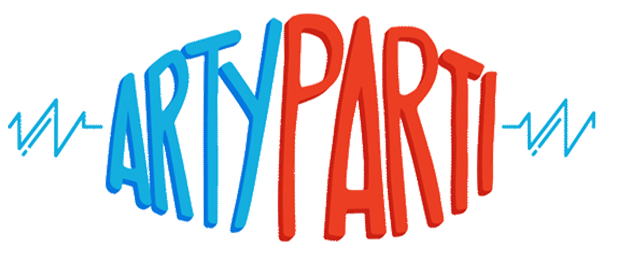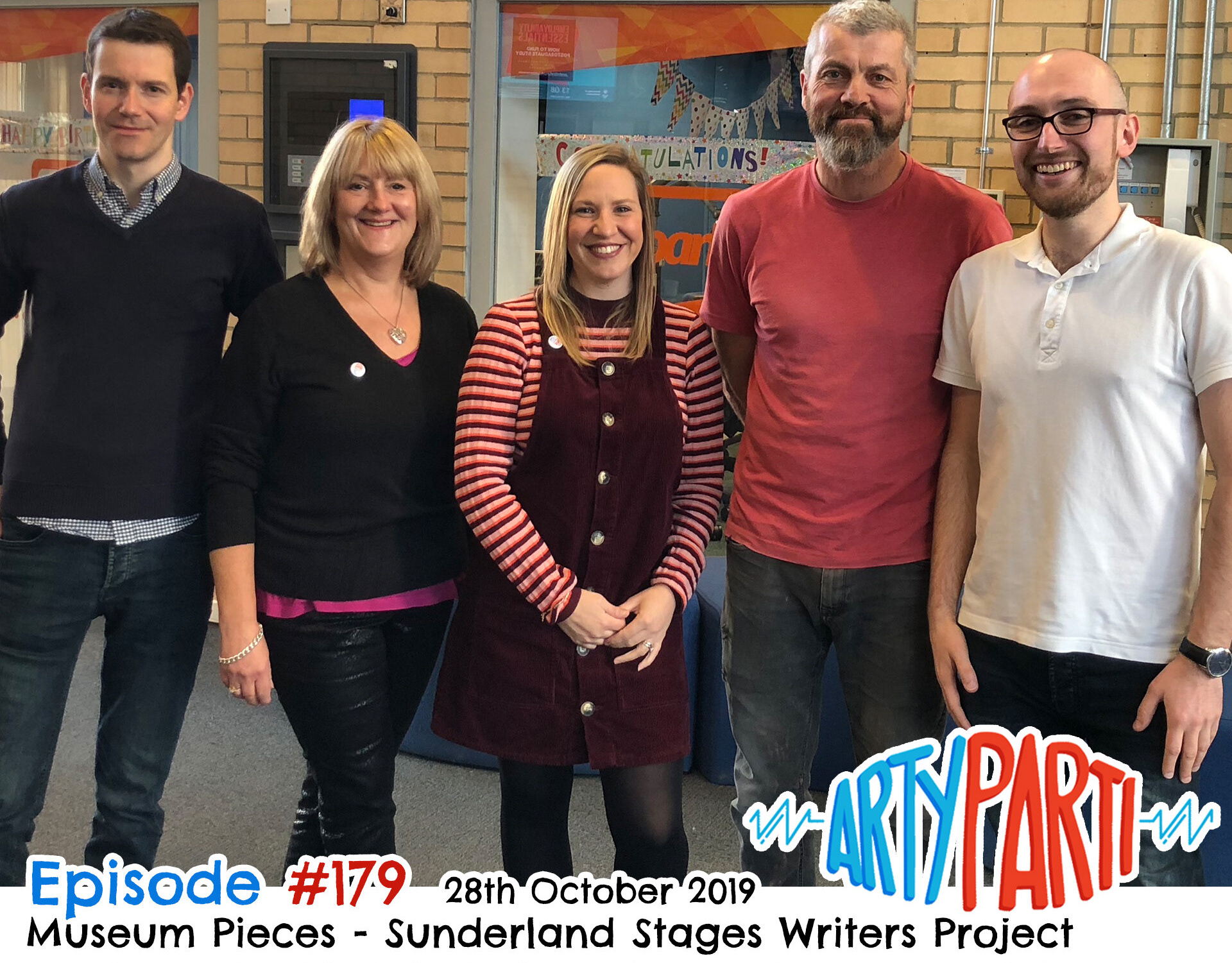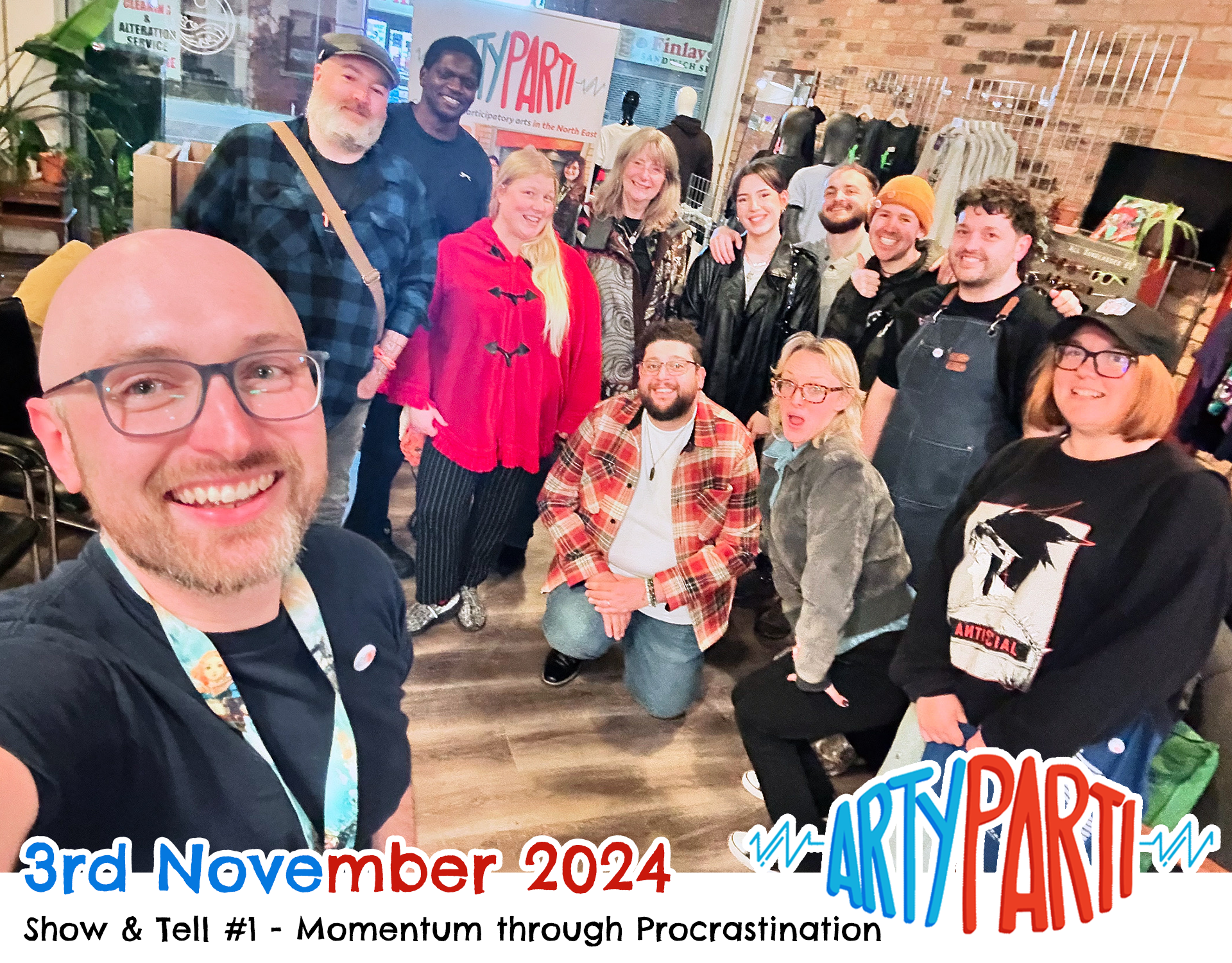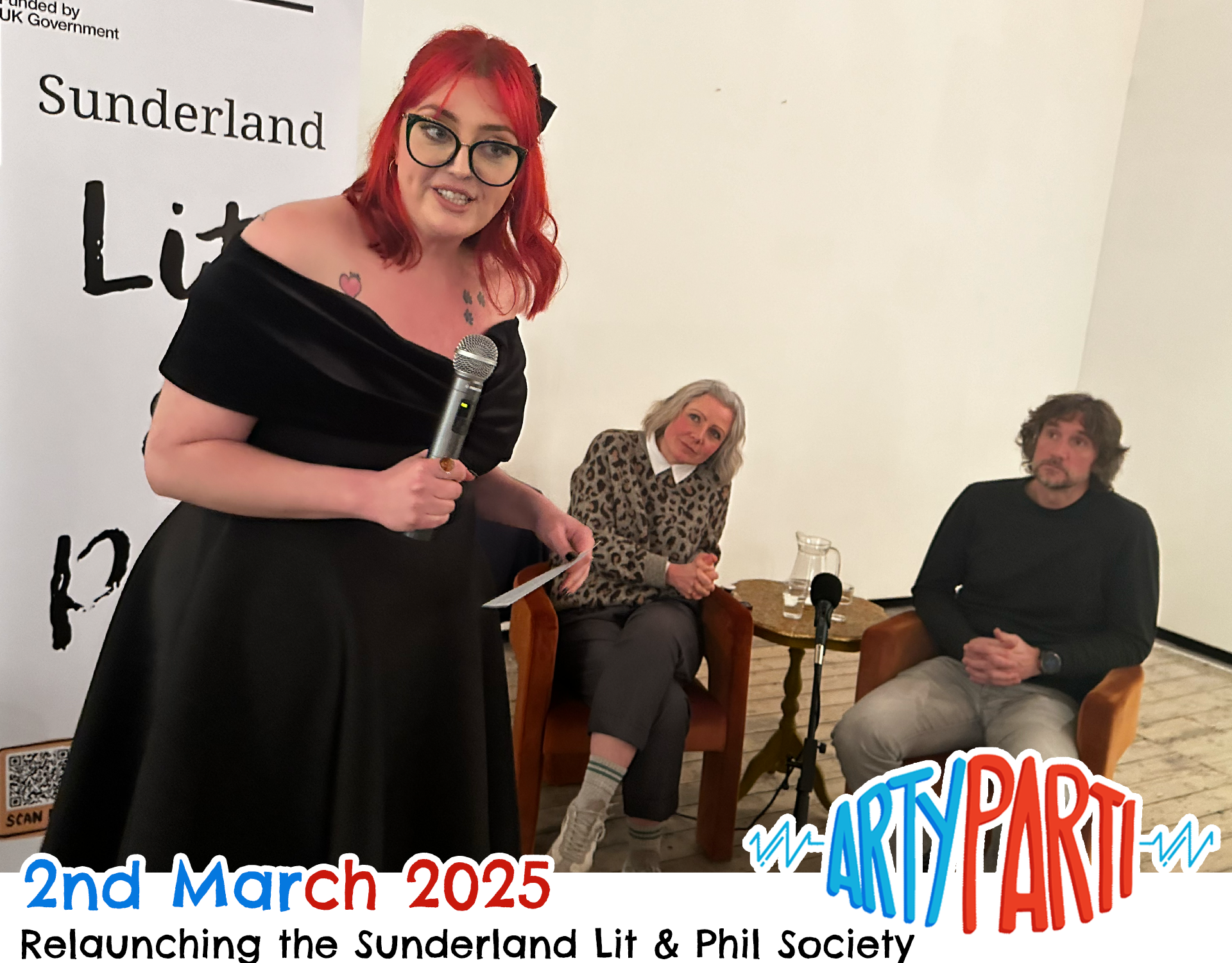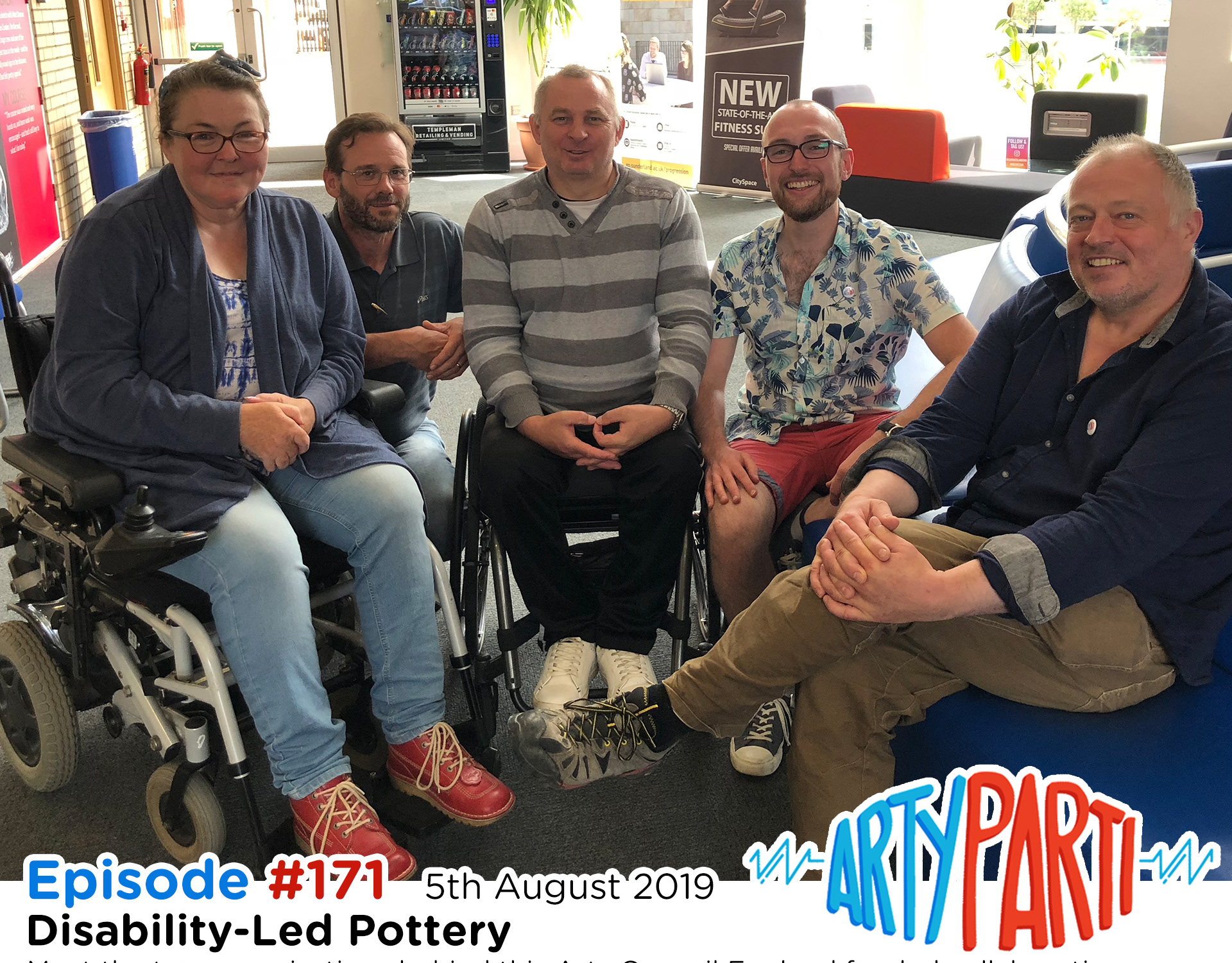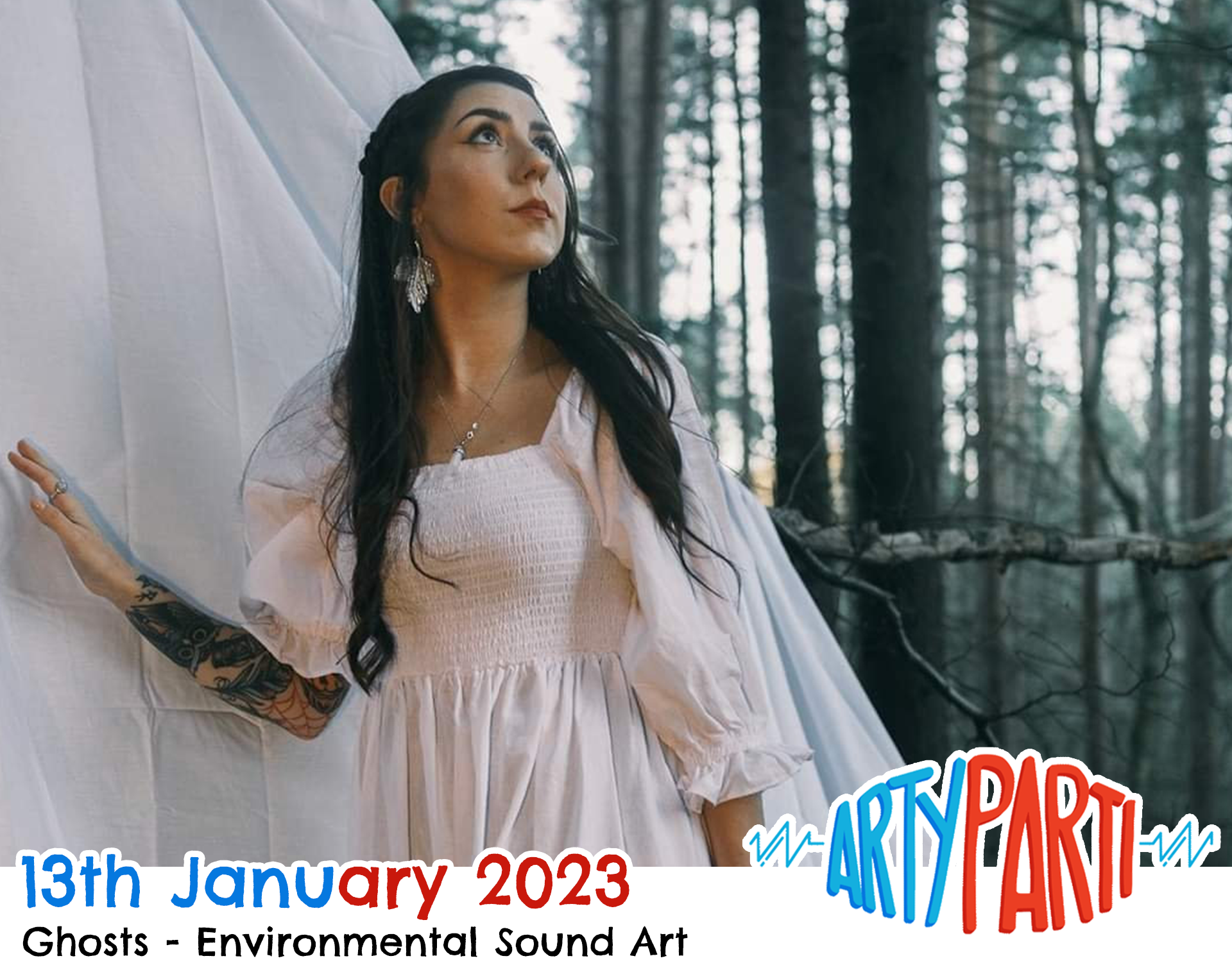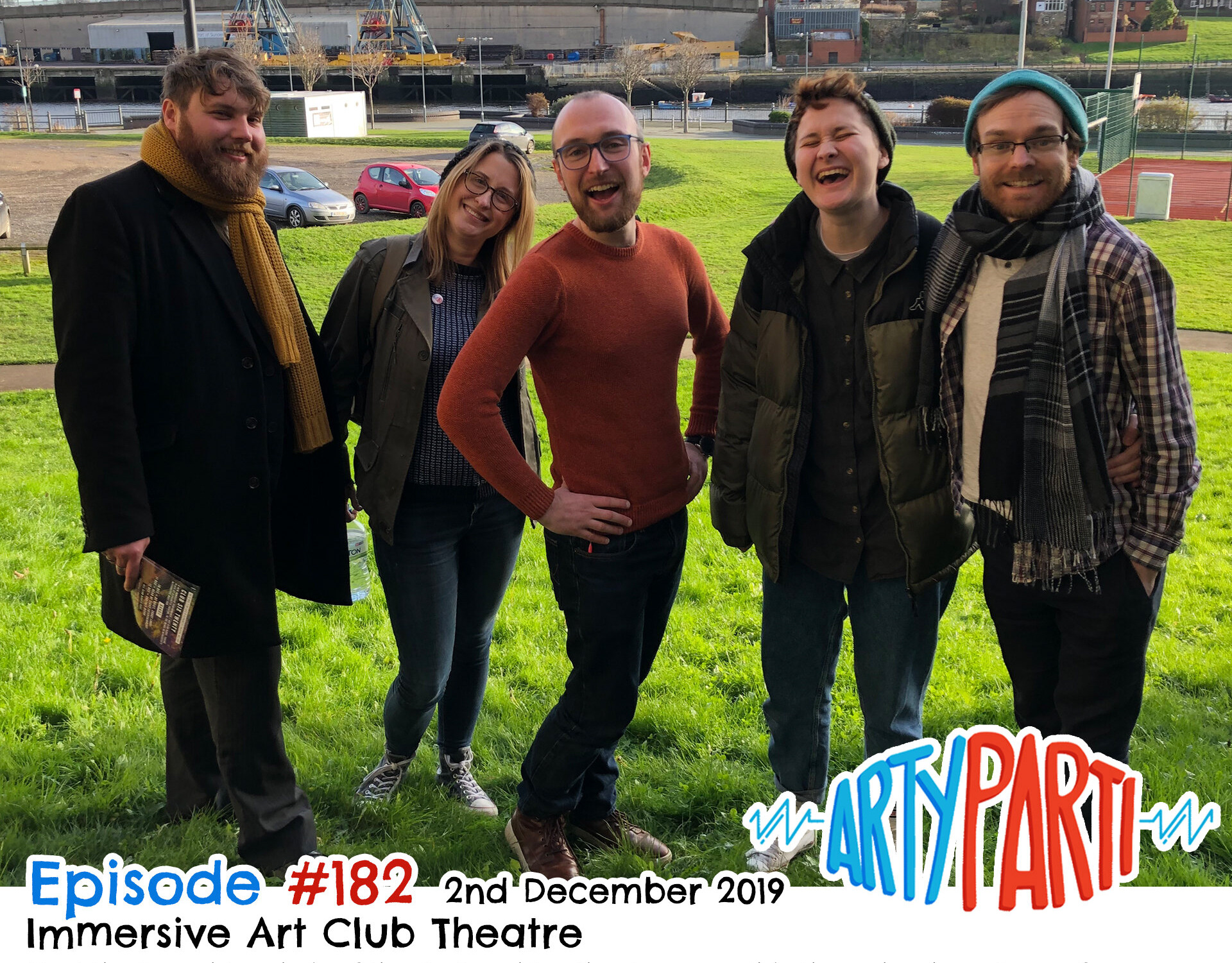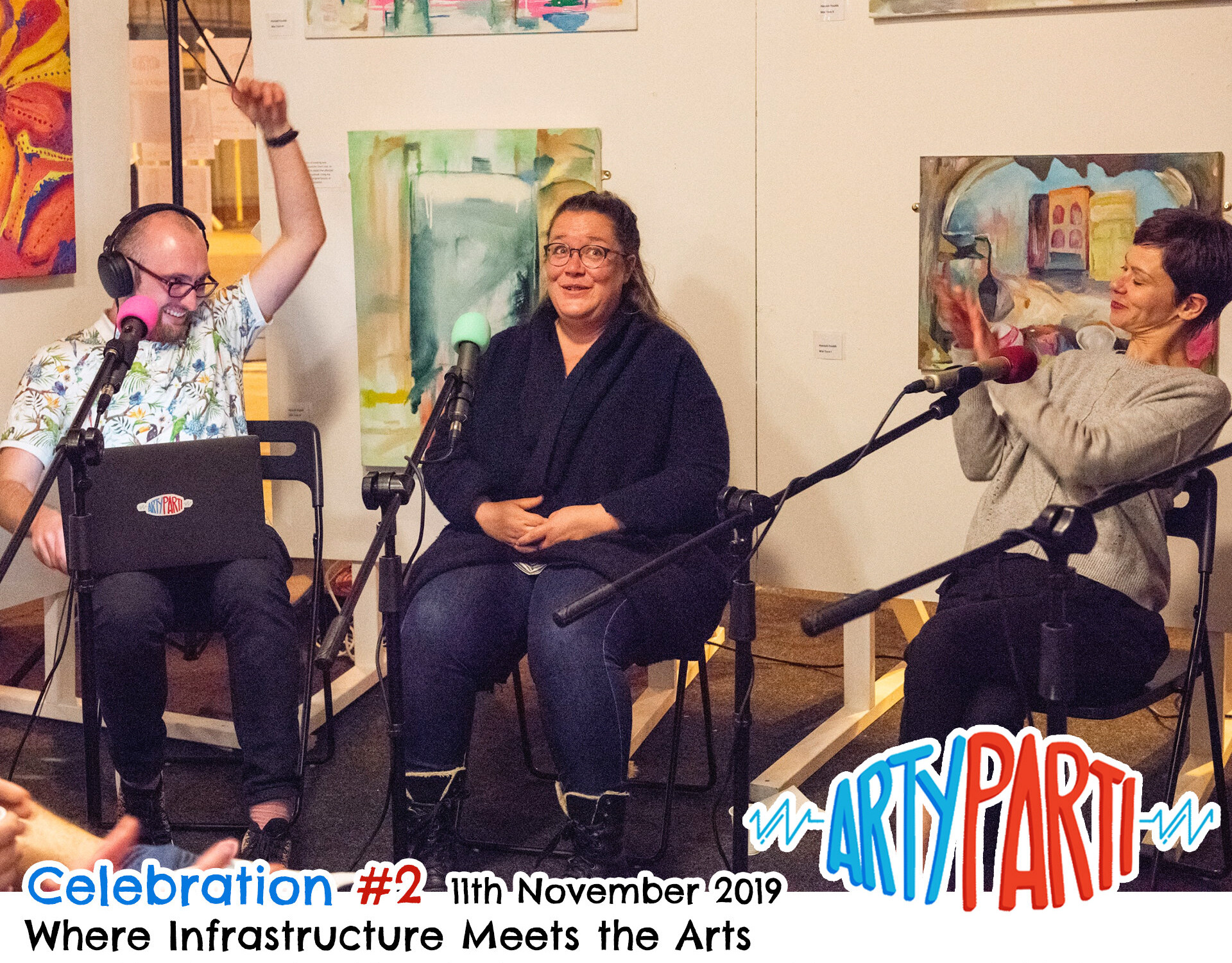Say farewell to an old sweet shop, reimagined as a revolving temporary exhibition venue for artists.
“[Mackie’s Corner] is a really quirky space. An old, unused building, it’s not just a white cube, and it does give you the problem of fitting work. You have to use creativity to your best.
"Every time exhibitions have been here, every panel have been used in different ways. To have been given to us as it is, it’s similar to my own art - taking something which is almost discarded, and making it into something beautiful.” - Anna Glover
This episode of ArtyParti was recorded in front of a live audience at Mackie’s Corner, a Sunderland city centre venue reimagined as an arts space. Meet the group of artists from “The Sunderland INDIE”, and hear how their practice was influenced by the building.
Recorded with a Live Audience: 20th September 2019
Guests:
Barrie West - Conceptual Artist
Kath Price - Textile Artist & Tutor
Anna Glover - Visual Artist
Barrie West - Conceptual Artist
Kath Price - Textile Artist & Tutor
Anna Glover - Visual Artist
A Jay Sykes Media podcast
Photograph by Amelia Turner
Some of the audience who watched the ArtyParti Celebration recording at Mackie’s Corner
JAY SYKES [00:00:00] Hello and welcome to ArtyParti - celebrating participatory arts in the North East.
AUDIENCE [00:00:05] (CHEERS)
THEME [00:00:06] (DESIGNED BY SOUND ARTIST MUSELEON)
JAY SYKES [00:00:10] My name's Jay Sykes, and welcome to our party. We are a weekly programme, podcast, and radio show, sharing the work of artists and creatives living and working in the North East. Whether grassroots, emerging, or established, everyone is invited. Tonight, in partnership with, Sunderland Culture, we are recording in front of a live audience at Mackie's Corner.
AUDIENCE [00:00:33] (CHEERS)
JAY SYKES [00:00:33] I would love to thank Sunderland Culture for your support. It's because of you that this evening is possible. I'd also, before we begin, like to thank, for taking their time to be with us today, the Right Worshipful Mayor and Mayoress of Sunderland, Councillors David and Dianne Snowden. Thank you so much.
AUDIENCE [00:00:52] (APPLAUSE)
Photograph by Amelia Turner
The Right Worshipful Mayoress of Sunderland, Cllr. Dianne Snowdon
JAY SYKES [00:00:55] For the past year, this building, Mackie's Corner has been used as a space for artists and creatives to exhibit their work. You might recognise it as the old Sweet Home Alabama building, as it's been for many years, and soon it's going to be redeveloped into another commercial property. But, this evening - it's not quite a memorial. It might feel like it in a way, especially to some of our artists. But we are celebrating the year of Mackie's Corner being used as an arts venue in the city of Sunderland. The legacy that is has left on the city, and the artists involved, and also looking ahead to the future. Barrie West please introduce yourself as an artist.
BARRIE WEST [00:01:38] I'm Barrie West. I'm a conceptual artist, but I'll try anything.
JAY SYKES [00:01:44] Barrie you are the co-ordinator of a group called Sunderland INDIE.
BARRIE WEST [00:01:49] Yes, guilty.
JAY SYKES [00:01:49] (LAUGHS).
BARRIE WEST [00:01:49] We had our opening show here about this time last year, and we had a footfall of well over a thousand people through; which showed quite a lot of popularity and a lot of interest in the arts.
JAY SYKES [00:02:06] And two of the members of Sunderland INDIE - I mean, I know that you also have had, some of you have had solo shows here as well - but two of their members are with us. So, let's introduce Anna Glover.
Photograph by Amelia Turner
Jay Sykes and Barrie West, addressing the audience
at our Celebration event, Mackie’s Corner
ANNA GLOVER [00:02:16] My name is Anna Glover. I'm a visual artist and creative practitioner here in Sunderland.
JAY SYKES [00:02:20] Anna you've had your own solo show, as well as being part of Sunderland INDIE's collective night.
ANNA GLOVER [00:02:26] Yes I did, this was last year in October. It lasted for three weeks, and I really appreciate the space, and the opportunity of doing so in Sunderland, because I have had solo exhibitions at other towns and other places. However, living here in Sunderland, I really appreciate that I was able to have a solo exhibition here.
JAY SYKES [00:02:45] Fantastic. And our third live guest with us tonight is Kath Price.
KATH PRICE [00:02:48] Hello Jay.
JAY SYKES [00:02:49] Please introduce yourself as an artist.
KATH PRICE [00:02:52] Well I'm Kath Price, and I'm a textile artist. So I do all things fabric, and many different techniques, and amalgamate lots of different weird and wonderful things - incorporating traditional heritage crafts, like clippy and hooky mat-making, but also I use lots of Indian saris in my work. And so it's a real mixture. And I also, like Barrie and Anna, was here last September for my first show in Sunderland - although I have actually shown my work in other places, particularly in South Shields. But it was a great opportunity, and the whole year has opened up a whole new field for me, which I can tell you about later on.
JAY SYKES [00:03:35] Fantastic. The first thing that I'd like to put to all three of you is; this space, what it has meant for you to be able to exhibit in the centre of Sunderland.
BARRIE WEST [00:03:44] Well, it's my hometown, and it was an opportunity, I think, to pay back to my hometown all the gifts that it's given me over the years. As you can guess from my accent, I'm not a Mackem. I come from the Deep South and, erm..
JAY SYKES [00:04:00] Where's the Deep South, Barrie?
BARRIE WEST [00:04:02] Devon.
JAY SYKES [00:04:04] (LAUGHS).
BARRIE WEST [00:04:04] Through the circumstances of being married to a Geordie, I landed up here. It's just a fantastic place to live, the folk are wonderful, and it's just a way to give back some thanks for welcoming me in, I guess. It's a very useful tool, right in the middle of the town. I mean, this is what the town needs - a hotspot for arts, to liven it up.
JAY SYKES [00:04:26] Do you feel like there is a hot spot in Sunderland, for arts?
BARRIE WEST [00:04:28] There used to be, but it's moved north of the river.
JAY SYKES [00:04:32] Where to?
BARRIE WEST [00:04:32] To the [National] Glass Centre. Putting back, I guess, the arts into the town centre, is what we're trying to do. Very very important for a city of this size with the creative output of the artists in this town to have somebody in the town centre. But it's not easy to do, it's not easy to do.
KATH PRICE [00:04:50] I think it's been important for artists to be able to meet together. That's what Mackie's Corner has personally done for me, because I've been very isolated. I didn't take up my career as a Textile Artist until later on in life, about 24 years ago - but I'd had another career entirely, in academia. I'm used to teaching, I'd been teaching in Sunderland since 1977, and, like Barrie, it is putting something back into the town to show how you've developed as a person over all these years. It's very significant, I've been quite isolated working away on my own. Meeting a whole range of artists, in other spheres of art, and all ages, I think it's a resurrection, you know? It's a wonderful thing.
ANNA GLOVER [00:05:41] It is also kind of really fruitful because when you are working as an artist in your studio, as Kath said, when you are yourself isolated, or even with other people in different studios, you don't have that kind of possibility to show your work. Being at Mackie's Corner, it just shows you how many commercial units that are available in Sunderland actually, which are free and empty, and how well they can be used by artists to just show their work. Not necessarily just create solo exhibitions, but to see and experiment with your work - because often, as I said, when you are in your studio you don't show your work, you don't talk to people, you don't know what you're capable of, and also you don't know how people actually react to your work. So this way, people come. They will be talking to you, you can, again, not necessarily just meet other artists, but also other people about. And you will have that connection, and you will have that discussion, and a discourse about what is actually going on in art world, which often you don't have a possibility to do so.
KATH PRICE [00:06:39] It does give you other opportunities to exhibit elsewhere. That's what Mackie's Corner has done over this entire year, because I've been working at the Frederick Street Gallery - both in Frederick Street, and in the new venture in the Bridges [Shopping Centre]. And that's a whole new world. There's lots and lots of different things going on there. You can go and set up in the window with your easel and paint on a Sunday there, if you want to. It's an opportunity for other artists to engage there as well. It's a good way forward to use the empty shops, in this way. I think it's a very enlightened attitude and I think we need to think about our city centres - the land use for our city centres - and how they need to change to respond to changing economic conditions.
ANNA GLOVER [00:07:27] And also the commercial galleries, the majority of time they only show artists which are established, of which come from different countries, or somebody who is at that point in contemporary art. Well, if you're an artist in Sunderland or in a small city, there is often.. you don't have that foot in to be able to get into a commercial gallery. So, it's just nice for your own kind of self-esteem, and development.
BARRIE WEST [00:07:51] It's kind of true in a way, but I think a commercial gallery is concerned with making money out of art. And a situation like this is good, because you can experiment, you can put it up on the wall and get a reaction from other people apart from yourself. If your art works, you'll be told. If it fails, you'll also be told. You don't need to put yourself out there and worry about whether the work is successful or not, because you're going to lose a sale. And this is this is one of the key things about using a place like Mackie's Corner - you don't have to play the capitalist game of doing what the market says, or doing what the consumer wants. You can choose to do what you want, you can you can take risks, do anything you want really. Throw it against the wall and see if it sticks. If it sticks, the public will tell you. If it falls off, then you've learned.
JAY SYKES [00:08:41] Cath, it looked like you wanted to say something to Barrie there.
KATH PRICE [00:08:43] I'm thinking about that. Yes. I don't really care what anyone thinks about my work. I'm not looking for accolades. I'm happy to explore it for myself, and I'm not looking - I have to say, I'm not looking to sell it. But, if commissions do come my way, that's a whole new ballgame. And therefore showing a wide range of the different textile techniques I do. What I have next.. In the next room at Mackie's Corner here is something that would never sell in a million years, because it's far too strong, and very much about the plight of children in the Yemen. And it's something I felt I needed to tell, and express my feelings and emotions about that. And it's done in such a way that it's quite personal to me, because I've used my 92 year old father's army blanket as a background, dated 1943. And he owned it when he was in the Middle East, at that time. The personal connection with my work, I don't expect other people to have that, but it may well resonate with them.
JAY SYKES [00:10:06] It definitely resonated with me.
KATH PRICE [00:10:07] Well you put it up for me, didn't you?
JAY SYKES [00:10:09] (LAUGHS) I did. But, I mean, it's something that very much unites both Kath and Barrie's work as well especially, is that there's something, in my opinion, very political about your work. It's commenting on..
BARRIE WEST [00:10:20] The social comment. Yeah, yeah.
JAY SYKES [00:10:21] Yeah it is. So Cath's work, what you're maybe going on to mention is that it also not just the war blanket, but also it attached to it are children's clothing.
KATH PRICE [00:10:32] Ripped garments. Baby grows, little dresses. And they are they are ripped not by me actually, but by a student of mine who brought them in having taken out the heart of them to make a patchwork quilt for a niece. And what I was left with was the debris, which I was asked if I wanted to use snippets of fabric, as I always do - I never refuse anything. Great recycler with the work that I do. But when I saw them arranged in a certain way, and I'd obtained the blanket from my father who lives in Gloucestershire, and Barrie had spoken from the Sunderland INDIE, well we were actually part of the group "All We Are Saying: Artists for Peace". The Yemen came up in conversation, and I got to think about how they could be depicted on this blanket. And they are not sewn on, they are attached with vintage nappy pins, because they are not permanent. And one aspect of my work is this concept of impermanence. It doesn't have to be here for a hundred years, and it certainly has to be changed with time.
JAY SYKES [00:11:47] It was a very moving piece. And then, Barrie, the first time that we met, again another piece with a big social commentary attached to it, was when you were creating your "Tower of Babel" piece - the gold-coated guns that were stacked together. I wonder, as artists, is the fact that there is a space here that's accessible where you're able to curate your own shows, does that feed into your work?
BARRIE WEST [00:12:12] It certainly helps, doesn't it? To have a place that doesn't rely on having to sell your work and get a commission in order to exist. If you can hang on the walls freely. Well that's our job, init? It's to communicate. And sometimes what we have to communicate is pretty serious stuff. Global peace. A 1960s peacenik here. You know, never leaves you. The world was in a terrible state when All We Are Saying started, seven or eight years ago, and we've been showing biannually since then, and it's still in a terrible state. So I'm not saying that we're making much headway against all the arms dealers and the armament industry, but we've got our say.
JAY SYKES [00:12:51] And being vocal, and having the opportunity to to make that voice heard is important?
BARRIE WEST [00:12:57] Yeah. Sometimes it's a silent voice, but it's a powerful one.
JAY SYKES [00:12:59] And then both yourself, Barrie, and also Anna Glover, you have both curated in this space - setting it up and working with the landscape of the walls. Which are not your usual white wall gallery. How have you found the experience of working with these spaces, as curators?
BARRIE WEST [00:13:16] You find a way, you find a way.
JAY SYKES [00:13:17] Aha.
BARRIE WEST [00:13:17] Yeah. It's not ideal, but it's better than nothing. And we can build with something. And we have a central philosophy that Sunderland INDIE is zero funded. We accept no money. Either in grants, or payment of any kind. If the artists want to sell their work they can, absolutely. But that's not our main aim. What we want is the independence of being able to create without the marketplace determining what we have to create, and that gives us the liberty to create anything basically. Also places like this gives us the freedom to express ourselves. This one that I put in next door, I've had battles over it. People don't like it because it's a hammer between the eyes, it's telling them how it is, that we're doing this. That's our responsibility. The weaponry that's being used by the Saudis originates in the West. We've just got to accept - we're partly to blame for that. The last time this point was made was in "Mapping Armageddon", you might remember that one at the Minster. That was even more direct and powerful, that.. Well, you can just you just say it so many times to people, and eventually maybe they will get the hang of it. It's just not a good thing.
JAY SYKES [00:14:30] One of Barrie's pieces about, at the exhibition he's just mentioning there in the Sunderland Minster, involved inviting the - is it the Pastor or the Vicar? How would you say, the.. Priest..
BARRIE WEST [00:14:38] Oh yeah, yeah.
JAY SYKES [00:14:38] ..To hold a large.. Brick, was it? What was the object?
BARRIE WEST [00:14:44] A building stone, what'd you call them?
JAY SYKES [00:14:45] A concrete slab of some kind.
BARRIE WEST [00:14:47] Concrete slab, yeah.
JAY SYKES [00:14:48] So, to hold a concrete slab over a pane of glass, and underneath this glass was the picture of a child.
BARRIE WEST [00:14:56] An Iraqi child.
JAY SYKES [00:14:56] To hold it, and to drop it, and to watch the glass smash over the face of this child.. It was such a.. I mean I didn't see it, but just hearing about it Barrie, it.. These are difficult statements to deal with, but you think that it's important that we are there..
BARRIE WEST [00:15:13] We've gotta own it. We've just got to own it. Because it's in our power to prevent it. We have the political power to vote governments in and vote governments out. And if a government is sort of saying that they stand for peace and pacifism, maybe they're the ones to be looking at, rather than those that want to get money and taxes out of the armaments industry. That's what I'm saying.
KATH PRICE [00:15:35] Apart from that, dealing with really big issues that are out there, we're also very much autobiographical in our focus. Well, I am, and I think Anna might say something about her autobiographical connections.
ANNA GLOVER [00:15:46] I was going to first talk about curating unusual spaces. Because we are artists, we are the inventors of the language of communication, and inventors of showing our work in different spaces. And I think it's very important to show it in different spaces. The white cube, which was invented some time ago, is not always the best way to show the work. It may be the best way, it all depends how artists look at it, but at the same time when you are experimenting with curating in different spaces it gives you the challenge of looking at a space in different, from a different perspective. Often you find yourself kind of wondering, you know, how are you going to put your work on a wall which is not necessarily able to drill in, or how you're going to fix them up? At the same time, I mean if you look at this space over here, there's lots of little quirks, and mirror and doors and.. You need to make a sense out of the space itself, and look at the work, and just make it relatable to the space, because not every word will fit here. And same time, every work may fit here if you make it fit, in the way that it should fit in. So, that was kind of about a curation.
JAY SYKES [00:17:02] And the conversations will continue after this quick message. If you've listened to the ArtyParti podcast before, you'll know that this podcast is made possible thanks to five generous people who support us on Patreon. Between them, we are able to cover the cost of our podcast feed. As ever, a big thank you to [name redacted], Jo Howell, Nicky Kaur, Stephanie Smith, and Laura Willis. More information about all five of our Patreon backers is available at ArtyParti.com. That's arty with a why? Party with an aye. Why aye! Dot com.
And now, back to our conversations recorded at Mackie's Corner, with Textile Artist and Tutor Kath Price, Conceptual Artist Barrie West, and, sharing about the influences behind her own practice, Visual Artist Anna Glover.
ANNA GLOVER [00:17:57] Talking about autobiography, I also came to art in my later life, only been kind of really "in arts" over last about 13 years. Prior to that, I was also partially teacher, and had my science degree prior to that. So, there was lots of other things going on, including being a mum of four. When I came to art, it kind of was ignited by my father's passion. My father used to do oil paintings, and he taught me calligraphy when I was very little, and he was very creative, in any material. I remember when we had a carnival at school and him making me costumes out of out of cardboard. Some, they were fantastic. Sometime I was opening a book, and he would decorate it, and he would paint it, and he would put a poem in there, and it was just something what I will never forget. And this is the kind of thing which ignited my passion. Apart from that.. I come from Czechoslovakia. We always had arts and crafts, kind of, in our blood. Brought up with embroidery, and making different types of mats. Recycling, reusing. You wouldn't throw anything away. You would use it to make something else - and if you wouldn't use it for making something else, you would trade it for something else. And when I came to this country, I was really taken back by how much things were just thrown away - in black sacks on the street, how many things being given to charities, or just literally just going in the bin. Majority of my work is actually made out of rubbish, and things that I've been given, because I don't see this as rubbish. I see as different kind of material, new type of material. Because everything is made out of something. So when you take that something into the elemental.. If you look at it elementally, you will actually see there's a material, something that can be again reused, or renovated - especially with throwaways. It had a past life, so why not bring that life back again to future, and make something beautiful out of it? When I was looking at my solo exhibition here, called it Žena, which was actually.. It's a Slovak word for a woman.
JAY SYKES [00:19:56] What was that again? Jana?
ANNA GLOVER [00:19:57] Žena.
ANNA GLOVER [00:19:58] It's a Slovak word for woman. A reason - one of the reasons for that was because my paintings, which are majority before the exhibition, I did were in gold and silver. So they were described kind of as something which is luscious, and expansive, and something like a jewellery. And I thought this will bring me into perhaps looking into my past, where my ideas and my motivation really come from. Because I haven't done that since I started university, my B.A. in 2006, and then my masters. I kind of learned lots of things about British art, about art from all around the world, but I never had the time to look into what actually brings my art forward, where my idea’s coming from. And when I started looking at that, it actually made lots of sense in why I make large artwork, and why does it look so solid. I looked into former Czechoslovakia and Slovak art, and put two and two together and actually realised that there is lots of influence from Bauhaus. When I kept looking at it, it brought me to different women in art who actually were not really known until perhaps beginning of this century. One of them is Maria Bartuszová - she actually was Slovak artist, Slovak sculptor. She lived about 30 miles from where I come from. Her work, actually, first time being exhibited in 2006. She passed away in 1996, which actually shows you how women being kind of.. Not necessarily undermined, but not taken seriously as an artist. However then I come across something which was exhibition from 1929 in Brno in Czech Republic called "Civilised Woman", and how the original beginning of Czechoslovakia actually was looking at a woman as very serious contender. And it was an exhibition of quite a few women, and they contained everything from visual artists, from designer, from textile work, from architect.. And between them, they actually created very serious exhibition, which was known all around Europe. But then after Second World War, again certain things again disappeared, and women, I suppose, were not so in the foreground as they started to be. So I kind of feel for Maria Bartuszová, knowing that she passed away in 1996, and really her work is just coming into foreground now. And in her collection, she collected over 300 works.
JAY SYKES [00:22:27] But you're taking this and moving forward.
ANNA GLOVER [00:22:29] I'm taking this and moving it forward, yes, hopefully.
JAY SYKES [00:22:32] I help facilitate participatory artists, and I know that the figure of female to male who work in participatory arts.. It does skew in favour of women. And I'd like to say that at least participatory arts - not "high art" - but I'm pleased that there is this this grassroots female focussed space, I suppose.
ANNA GLOVER [00:22:50] One of the things I think why participatory art is more in women, is because people used to say the explanation is the caring nature of women. We're more caring, in a way, of looking with with people, working with people, and working with communities. But it's not necessarily true, I mean there are also men who do. It's just.. I think it's the nature of politics, unfortunately, skew it sometimes in favour of one or the other.
JAY SYKES [00:23:13] So I would love to ask all three of you then, based off of your work here, the exhibitions that you've had, the interactions that you've had with the public who have come into this space to see that work, to comment, and to network as you were talking about earlier... How have you found that it's influenced your own work moving forward, and have you changed your practice based on its interactions in this Mackie's Corner?
BARRIE WEST [00:23:34] Not at all.
JAY SYKES [00:23:35] Not at all?
BARRIE WEST [00:23:36] Not at all.
AUDIENCE [00:23:36] (LAUGHTER)
BARRIE WEST [00:23:37] Because my work was political to start with. All I have now is a bigger audience. I've looked at rough sleeping in Sunderland - that was there was a major concern - and that the sculptures I did for the rough sleeping were shown in February, I think it was, at Washington, at the Arts Centre Washington. There was an immediate response to the rough sleeping sculpture. It's because it's seen as as a social problem. I'm certainly glad there's two sets of chains in front of me to hear this one. That they're now. They want a place to sleep. The problem is that the hostels that we provide haven't got enough beds, or there are not enough hostels. We have to sort them somehow, we have to do something. Hey I never miss a chance.
AUDIENCE [00:24:19] (LAUGHTER)
BARRIE WEST [00:24:19] Never miss a trick.
THE RIGHT WORSHIPFUL MAYOR OF SUNDERLAND CLLR. DAVID SNOWDON [00:24:23] So you shouldn't.
JAY SYKES [00:24:23] Sorry, go ahead Kath.
KATH PRICE [00:24:25] I was humbled to be able to produce the political work - independently of Barrie, but on the same theme, which I probably would not have even considered if I hadn't been in Mackie's Corner to be able to experiment in that way, and suspend, you know, a seven foot blanket from the beam. My focus over the last few years has been more autobiographical, and to do with women, as I've had strong feminist influence in the way I work for most of my life, or at least since 1970. I also applaud the designer Laura Ashley. From the designs that she brought out on her kitchen sink in 1954, through to the 1970s and 80s when I was a homemaker, and buying the little bits of off cuts and scraps from her shops, making do and mend in my home. So thinking about the kind of artwork I might do to celebrate her, and to incorporate other materials; all those tablecloths that end up in charity shops that have been beautifully hand embroidered by generations of women, for their bottom drawers, and the younger generation who've never heard of the bottom drawer. But that's another story. To make work that applauds and celebrates the hidden women who produced all of those things and more, and also to make statements about my own life. And, I produced a path, a Laura Ashley path, starting on the 1st of January 2018 going right through to the 31st of December 2018. I wasn't working every day, but that path was shown with my other Laura Ashley pieces that have been applauding the humble apron. And all of those were shown this year.. I'm not going to say it's my last, let's be optimistic.. My first solo show here. Those aspects will continue to mould me, and those around me, I hope, as I continue my quest to show these skills and share my skills with other people, so that they will also take on board the value of slow stitch. It is a philosophy. It is important for everybody's health to do most things slowly, including stitching.
ANNA GLOVER [00:27:04] Somebody once said that every artwork is a political artwork, because it's always in reaction to something, or as an answer, or as a mirror to something. So it doesn't matter if it is geopolitical, or if it is cultural, or if it is ecological. Every artwork you look at, it's a reaction from or for something. So when you're talking about political art.. I mean I have done some angry political art prior to now, I think I kind of toned it down a little bit because I wanted to feel a bit better about myself, and not only in response to political things that's happening lately, because I think it would hurt me pretty bad. I'm quite a soft person in that respect. So, I need to protect myself, and I think the way how I protect myself is by making my art.
JAY SYKES [00:27:49] I'm pleased to hear that. I am. The fact that Mackie's Corner has existed as a space not just for solo exhibitions, as you're talking about, but also for the joint exhibitions under Sunderland INDIE, under EMC Arts earlier, 2020.. I mean there's so many groups that have used this space. And again, here with ArtyParti as well, hello audience, hello everybody.
AUDIENCE [00:28:14] (HELLO AND CHATTER).
JAY SYKES [00:28:14] I love that Mackie's Corner has been in the city of Sunderland to provide a space for people to get together. As you were talking about earlier Barrie, it's about the the networking opportunities that it provides for people, the visibility that we can give to artists in Sunderland, to have a space available for them, and also to, as you hinted on earlier, to reflect against each other's work, and for that to impact and influence your own. And I really want to again thank Sunderland Culture for giving me, for giving ArtyParti the opportunity of getting people together in this space for this last hurrah. To see off the wonderful space that has been the two shop units of Mackie's Corner, being used as a venue for arts.
SOUNDS [00:28:59] (THEME BY SOUND ARTIST MUSELEON)
JAY SYKES [00:29:01] Over to you. What should ArtyParti be covering next? And what could we do differently as a podcast? I would love for you to get in touch on Twitter. We are @ArtyParti, and our website is www.ArtyParti.com. Both are Arty with a why? Parti with an aye! Why aye. Please let us know how we could improve the podcast. And if you are an artist or a creative, living or working in the North East, and you'd like to make an appearance on the show, well, let's make that possible.
JAY SYKES [00:29:37] I wanted to open up this last section of ArtyParti - words to Mackie's Corner as a space. What's the last thing that you want to say to this building before it closes for redevelopment?
BARRIE WEST [00:29:48] Can we mention seagull feathers?
JAY SYKES [00:29:54] (LAUGHS) Steph? Go ahead, mention seagull feathers.
BARRIE WEST [00:29:59] You have to chase seagull feathers here. They come in in tonnes.
KATH PRICE [00:30:03] I think they're angels, rarely.
BARRIE WEST [00:30:05] They're a pest.
AUDIENCE [00:30:05] (LAUGHTER)
STEPHANIE SMITH [00:30:08] They're hard to hoover out of this carpet, I'll tell you that much.
JAY SYKES [00:30:09] What's that, Steph?
STEPHANIE SMITH [00:30:12] I said they're hard to hoover out of this carpet.
JAY SYKES [00:30:15] Especially with that Hoover in that closet, that does not work properly. Maybe the seagulls deserve to see the art as much as humans do.
POSY JOWETT [00:30:23] (LAUGHS)
KATH PRICE [00:30:25] I'm struck by the warmth, and I'm struck by the good-heartedness of both the people who make the work, and the people who've come to see it.
JAY SYKES [00:30:36] Thank you Kath.
ANNA GLOVER [00:30:37] I think it's bringing the history back again alive, because it's supposed to be a very old building with lots of historical connotations of Sunderland. I think it can be an opportunity to become a little bit more colourful for a year, and bring in people which possibly otherwise wouldn't even come to this place.
JAY SYKES [00:30:56] Thank you Anna.
SOUNDS [00:30:56] (ARTS SOUNDS)
JAY SYKES [00:31:01] The magic of editing.
AUDIENCE [00:31:02] (LAUGHTER)
JAY SYKES [00:31:06] Posy Jowett, please "Posy" your question.
POSY JOWETT [00:31:08] Okay, so, I was really interested, Kath, in what you had to say about you were making work that you felt like you wouldn't otherwise have been able to make, apart from having this space available to you. And Anna, you talked about everything being made up of elements. And I suppose I wondered what you guys thought about this space being an integral element in the work. Like, how does it feed in to the work? How does it become part of the things that you make in your.. In terms of your thinking about producing it, and then in displaying and curating?
ANNA GLOVER [00:31:41] For me this place, as to have been given us as it is, it's kind of similar to my work really - taking something which is almost discarded, and make it into something beautiful. The other one is more like a white cube, however this one is really quirky space. And it had lots of different things when we came in which we had to move about, or kind of position in such a way that it would work different types of exhibitions. Because every time exhibitions been here, every single panel has been positioned in different way. So I think it's.. When you take in this kind of old, disused building with funny flooring, and we had to often adjust under under the boards with piece of paper, or a piece of card, or a newspaper, or something.. It actually makes you feel more human. It's not just a white cube, where you have to be precise and perfect. It's actually makes makes you feel more homely, and easier to work with, and at the same time it does give you the problem of positioning the work, because the walls are very fitting unfriendly. So with that kind of challenge in mind, you do have to use your creativity to your best. But that makes it kind of more homey and more friendly, and not so precious.
JAY SYKES [00:33:02] Kath?
KATH PRICE [00:33:02] That's the point; not so precious. I think I've intimated I'm not particularly precious about my textile pieces, and it's very gratifying to know that a hammer and nail would do wonders. You know? No measuring, screwing things to the wall, having little brass plaques.. For us, hammer it on, nails. Let's have an apron going in that direction.
POSY JOWETT [00:33:27] (LAUGHS)
KATH PRICE [00:33:27] Let's have another apron going in that direction. So you could be quite free. And that's what I think.. I think that's the fun.
POSY JOWETT [00:33:40] Because you're allowed to respond to the nature of the space, aren't you? So your work has to fit in this. It can't feel like a fish out of water in here.
KATH PRICE [00:33:47] No, it, well, it would possibly in other places, but this could go higgledy piggledy and people could respond. And the response to aprons was quite amazing, everyone had their favourite. And it sometimes resonated with their family, and the aprons worn by family members. It's personal. Clothing is a bit of heritage we tend to forget. I'm a bit upset that the Textile Gallery has been closed in Sunderland Museum and Winter Gardens, and now the only place you can see textiles and clothing on display, which we all wear, through all the ages, is at the Bowes Museum. So, for me personally, there's a lot more work to be done. There is a group called Threads, we meet monthly in the [Sunderland] Museum and Winter Gardens, and we share our skills with anyone who cares to come along. So it's still going on.
LOES VELDPAUS [00:34:45] I was wondering; so you got to use this space for a little while, right? It's really this meanwhile use of space. So if you had the opportunity, would you like to stay longer, or would you actually find it more interesting to move in different spaces in the city. Or, if you can dream would you want the whole building and have spaces to work here as well? I'm just very interested, and there is a nice opportunity for you to use this space for a short while, but like would it be of interest to do it longer or different if the possibility was there?
BARRIE WEST [00:35:14] Do you have any influence?
AUDIENCE [00:35:16] (LAUGHTER).
BARRIE WEST [00:35:16] Is it- Could you could you pull a few strings for us? We would really like it.
ANNA GLOVER [00:35:21] I think as an experiment it was a fantastic experiment. People enjoyed it. At the same time, I think what we need, to keep it experimental and perhaps use every year a different building. It gives you a different challenge, and also it moves art into a different part of Sunderland. Not always people will be passing through here, so if you take it to elsewhere there will be different audience. People will come from different places. And perhaps after maybe two or three years, people start getting used to having art in the city.
BARRIE WEST [00:35:50] Do you know, I radically disagree with you there. I think you need one place in the middle of the city where people will know that there's going to be art and culture and creativity on tap. No matter what time of the year it is.
JAY SYKES [00:36:03] Or, Barrie, should not be 20 places?
BARRIE WEST [00:36:06] Ooh, or 20, of course, of course.
KATH PRICE [00:36:06] There could be both. There could definitely be both!
ANNA GLOVER [00:36:06] It would be nice to have one cultural space, but it would also be nice to have a pop-up.
BARRIE WEST [00:36:06] We could call it an art centre!
AUDIENCE [00:36:08] (LAUGHTER)
LOES VELDPAUS [00:36:08] Radical idea! (LAUGHS)
BARRIE WEST [00:36:19] Ooh, we have one, haven't we? We already have one. We could get the old arts centre that's not an arts centre, and turn that into an arts centre. Oh, we're getting political again, aren't we?
KATH PRICE [00:36:26] We could be open for longer, too.
MIETEK PADOWICZ [00:36:29] Hi, Mietek Padowicz. I want to agree with Barrie, because Newcastle has lost a massive artistic centre, because the city centre has been turned into Stacks and a couple of other things. And all of the photographers, the sculptures, the painters, the writers, the theatre people, have been scattered higgledy piggledy all over the city. Now you can't find anything, you sort of go a little bit here, a little bit there. We need a place where everybody can come together, and you know that if you just throw across the road there's something going on, and up in that building, on the fourth floor, and the third floor, and we all come together. I'm losing an office in the space right now because within two to three years it's going to be pulled down, and I'm not staying in there. But guess who's in there? All the artists. And we're now being told that we're going to Shieldfield, because that's the next big place where the City of Newcastle wants us to go, and pay more money for smaller places that won't be open 24 hours. We need a place where all the artists can be together.
BARRIE WEST [00:37:28] Yeah.
KATH PRICE [00:37:28] In the centre.
MIETEK PADOWICZ [00:37:29] In the centre.
BARRIE WEST [00:37:31] That sounds very familiar, that kind of manoeuvring.
MIETEK PADOWICZ [00:37:33] You're welcome.
JAY SYKES [00:37:34] Steph!
STEPHANIE SMITH [00:37:35] What I've loved over the last sort of, well, five six years, seven years.. How long's Pop Recs been going now?
LAURA BREWIS [00:37:43] Five and a half years.
STEPHANIE SMITH [00:37:43] Five and a half years. So we've had a similar situation, a similar experience here. Pop Recs were allowed to use what was the old tourist information shop on Fawcett Street, and that was meant to be a very temporary situation. We had the same situation here [at Mackie's Corner], there were a couple of exhibitions at the back end of summer 2018. We were given it back end of August, September. We were initially told by Barrie, when Barrie was told by the building owners, we're gonna have 10 people in for a week. We've got a one day turnaround, we can have another 10 people in for another week. Right, get on it. And we got in, we stayed for two and a half weeks, then we had to quit change over. That exhibition was on then another three or so weeks, and then we were given it for longer. So Anne got the opportunity to have a solo exhibition here, and it just kept getting extended and extended and extended. And while there was a will, and people finding a way, and Barrie being such a brilliant communicator, people kept popping up out of the woodwork and saying "I'm an artist too. I haven't exhibited in ages," and the whole thing's kept rolling. And it's been over for a year now. And I know we've been told we've got to get out, but from what I've heard they're like well you got to be out next week. Actually, it's been delayed a bit. So can you make use for the next fortnight? And they're happy to have us. So I totally agree with the idea of a permanent space, 100 percent. Darest I ever disagree with Barrie, my mentor. But, the idea of also having the pop-up spaces, and local people going, "hang on, wasn't this a sweet shop? What are you all doing in here?", and having that unexpected pop-up experience in an unfamiliar, non art white cube.. It's good for the people, it's good for the artists. And I don't know who's been involved other than the building owners, but everyone's been so generous, and it's it's it's extended and extended and extended. So, we might be here in three years time if they don't get planning permission, and the plumbers are late. So, see you next year.
AUDIENCE [00:39:59] (LAUGHTER).
JAY SYKES [00:39:59] Thank you very much indeed.
AUDIENCE [00:40:01] (CLAPPING AND CHEERING)
JAY SYKES [00:40:08] Our guests today were Conceptual Artist Barrie West, Textile Artist and Tutor Kath Price, and Visual Artist Anna Glover. ArtyParti's live events and website are made possible thanks to support from the Arts Council England, and the National Lottery Heritage Fund, through the "Unlock" strand of Sunderland Culture's Great Place scheme.
